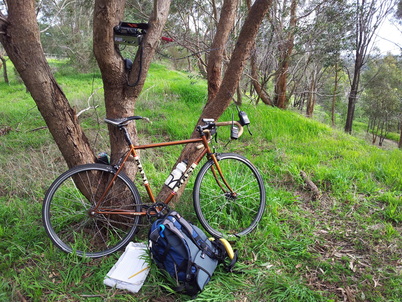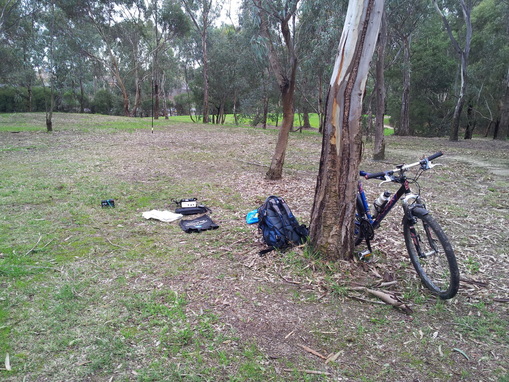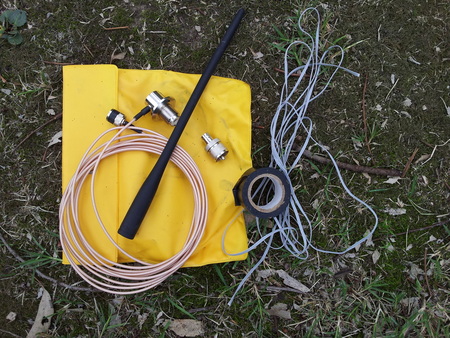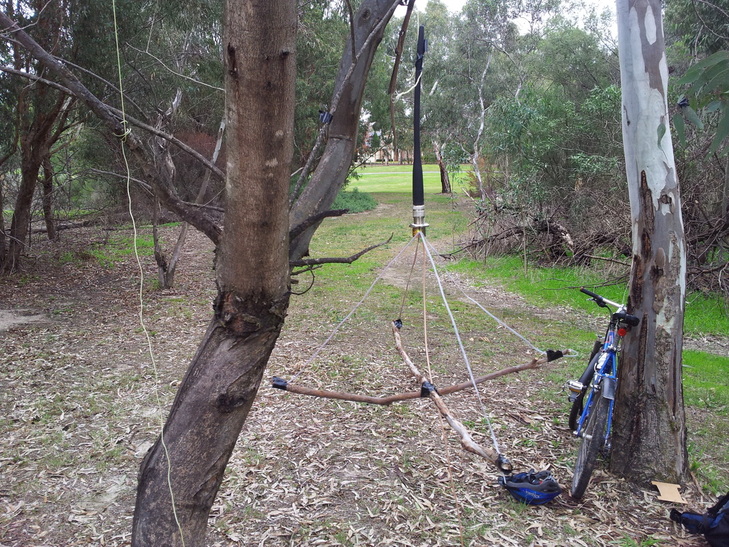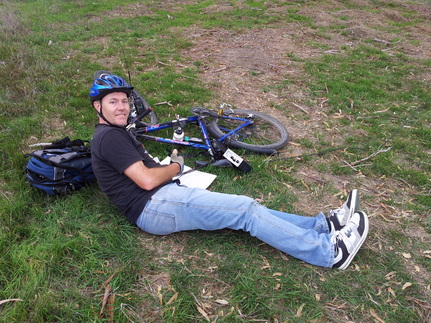I love having a hand-held radio with me whenever I go cycling, hiking, camping or SOTA activating. I often carry one when strolling around on weekends. I like to carry one around major public events, using it like a scanner to listen behind the scenes. Like a classic RF geek, I have listened to race crews communicating with their drivers during the F1 Grand Prix and spoken with other amateurs for hours in Bass Straight whilst maritime mobile. I've communicated with people while flying in light aircraft and used satellites and IRLP to talk around the world from relatively remote places. All of this from a little radio that fits in the palm of my hand. Simply remarkable. Although an HT is not the answer for everything, I'm still amazed at what can be done with a cheap radio that can be clipped on my belt or hidden in a pocket. Next to my FT-817ND, for portability and maximum usefulness when out and about, there is no doubt a half decent HT is the next best thing.
I have been considering the purchase of a high-end brand name hand-held transceiver for a while. I think some of the additional features available on some more expensive models could be very useful for my SOTA activations and regular wanderings into remote areas. But is the substantial additional cost of these rigs versus the brilliant value from some of the Chinese HT offerings worth it? Maybe, but we need to assess our use and needs and play with some of these radios to see if the value is really there.
I'm no stranger to dual-band hand-helds. The first one I owned was a Wouxun KG-UVD1P. This unit was a fantastic first radio. I treated it with no respect whatsoever. It was dropped, scratched, booted about, left outside in the rain and thrown around for over 4 years without much love. It continued to work reliably even when the display would fog up with condensation in extreme weather and I couldn't see what frequency I was using. Other than a breaking the original antenna, nothing stopped working other than the built-in LED torch. After years of torture the display finally died before my eyes when using it on a SOTA activation. I still have this radio and it is still usable without the display. I have all VK3 and VK7 repeaters programmed into the memory and can simply put it in scan mode until it finds a repeater. The female voice option still tells me what channel I'm on an her strong Asian accent. She now lives as a spare in the car just in case. I reckon that the original purchase price of about $130 was a steal and this unit has served me extremely well.
I also own a Baofeng UV5R purchased online from Hong Kong for under 50 bucks. An amazingly small price and a worthy contender against my first Wouxun. With a higher capacity battery and a solid feel, it is almost the perfect throw-away HT, however two major things let this radio down. The stock antenna as supplied isn't the best performer. The receiver also suffers from a lack of selectivity. The squelch opens and it frequently farts, pops and comes to life with interference from various unwanted sources, even in some remote areas where such noise would not be expected. On the positive side, it's tiny size and reasonable TX and RX audio quality are very good.
When the display on my original Wouxun died, I considered much pricier radios to replace it such as the Yaesu VX-8R and the Kenwood TH-D72A, but I'm glad I held back. After much deliberation and wanting to stay on the right side of my wife who fails to understand why I need such an expensive HT, I purchased another Wouxun, a KG-UV6D this time. Accessories such as the speaker mic and the batteries from the other one were interchangeable (but not the antenna as the SMA connector is reversed).
The KG-UV6D seems to work marginally better overall on both 2 metres and 70 cms than the other two units. It also has a higher IP rating to better resist moisture. Up to 200 memories can also be programmed rather than 128 memories of the others. Apart from cosmetic appearances, these three radios are all fairly similar in use and practicality. Should I lose or destroy any of these radios while out in the wild, I wouldn't be too upset for the money spent. It makes around $600 for a dream HT from one of the big brands look extravagant, regardless of the extra bells and whistles. Bang for buck from these Chinese radios are excellent and they all deliver the features I expect of a amateur HT with DTMF, dual watch, broadcast FM reception, wide band receive capabilities and more. The keys on all models are illuminated well and are easy to navigate. I can read the displays on all on all three without my glasses. The nice bright LED torch function is a useful additional feature on all three models, however it is a shit that these nice bright LED torch lights all died within the first month or so of ownership. Fortunately their primary function as reliable communication devices has never been an issue.
A while back I put these radios up against a Yaesu FT-60 and the results were surprising. Did the FT-60 perform twice as well as the others, considering it's price? Unfortunately not. The basic features, huge memory capacity and solid build were there but it on RX performance it was deaf outside the amateur bands. Whilst we could hear police, SES and CFA on both Wouxuns and the Baofeng, the FT-60 struggled. It also lacked the battery capacity and ability to receive broadcast FM, a nice feature to have if you want to tune to the latest news, weather reports, listen to Triple J or ABC FM on the way down from that SOTA summit.. Other than that, it was on par with the others but not worth the extra cost, especially if I wanted to buy any accessories at four times the price of of the others.
More recently I've been playing around with an Icom IC-91AD, kindly on loan from a member of my local radio club, the EMDRC. It has some features that I desire in the perfect HT. An exceptionally wide RX coverage from 0.495–999.990 Mhz. D-star capability is the major capability and selling point of this radio. As a D-star device it works as expected, apart from the quirky menu and initial programming and setup. I was disappointed with the display and the dim illumination of the keypad – all hard to read compared to most other hand-held radios I've played with. Maximum RX volume in D-star mode is quite low. I appreciate a bit more punch from the speaker in some situations. It has a solid cast aluminium body and looks and feels the part for a high-end amateur HT but has little more to convince me of spending around $600 to own the current equivalent model, the IC-92AD, which is similar in most respects.
If D-star is your thing, fair enough. I have found the hype about D-star doesn't really meet my needs or expectations. That's not to say that I haven't found it interesting to play around and explore the possibilities of the mode. I find it thwarted by latency and dropouts, garbled and robotic sounding voices from time to time and barely worth the additional expense. There are current concerns here in Melbourne for the long term survival of the major D-star repeater and gateway. This is a worry for anyone considering the purchase of a D-star capable radio for the future. Sure, the ability to talk to others around the world is a bonus. But then again worldwide contacts via IRLP and Echolink are easily accessible through more repeaters on most handies at a fraction of the price and without any prior configuration by simply using the DTMF codes from the keypad. In my introduction to D-star, the mode seems to be quirky and awkward to configure in some radios. It is strange that I have spoken with more people using dongles plugged into their computers rather than a radio on D-star, possibly because the Internet is more reliable and has greater range than the local D-star repeater. Go figure?!!
The Icom IC-91AD has another unintended advantage in the snow or extreme cold. It is a wonderful hand warmer. It would be great on those higher SOTA peaks in mid-winter. Compared to most other handholds it gets very hot – almost too hot to hold comfortably if blathering away on long overs. RX also suffers terribly from intermodulation and interference on 2 meters – far worse than even the Baofeng at a tenth of the cost. On the upside, It is a strong and capable transmitter with good reports on audio quality and modulation in both FM and D-star modes.
Would I buy one? No! I expect a much better user experience and features for that sort of money. APRS and GPS capability built in to the radio would be a start. Some higher priced brand name handholds have these capabilities but often need an expensive plugin accessory to be fully functional. My ideal radio would need the highest available IP rating (submersible) as well as wide-band RX. These would be my minimum requirements for a high-end HT. My requirements therefore rule out several currently available high end models.
These additional features and their usefulness is limited by the type of radio a HT is. A HT is designed for use on the move, not just for when you've arrived at your destination or operating spot. In terms of coming close to broad band receive capabilities, put a Yaesu FT-817 or an Elecraft KX-3 with a few metres of wire for an antenna against any HT and the HT will fall a long way short. Most hand-helds lack sensitivity and cannot resolve SSB signals. Many lack an internal bar antenna for improved reception of the AM broadcast band. Like many compact 'do it all' devices, certain features like GPS will do the job but may disappoint in degree of usefulness when compared to a dedicated device like a Garmin or even a smartphone that can render your route, waypoints and current position on a map.
The GPS units on some HT radios lack sensitivity or can be awkward and expensive in use, with an additional external unit that attaches to the radio. APRS coverage is by no means guaranteed everywhere, nor can it be relied upon any more than your mobile phone might work as intended in a remote area. D-star or any digital mode of transmission will only work when in range of someone else with the same capability or a repeater capable of the same mode. Using these extra features will chew through your battery much faster than a radio without these fancy bells and whistles.
Out of the latest HT radios on the market, I'm most interested in the newest offering from Yaesu, the FT-1DR. From my research it seems to have everything I desire of such a radio. It costs around the same as all the other top range units from other manufacturers and packs APRS, GPS, wide-band RX and can stand the adverse weather and moisture well. The new digital mode may not yet have the following of D-star or be compatible with DMR or P25 digital protocols but in time may find acceptance in the market. It promises better audio quality than D-star and the ability to communicate in digital mode with FM analogue transceivers through repeaters equipped with the Yaesu Fusion digital system. Rumour says that Melbourne could have a Yaesu Fusion digital repeater operating in the eastern suburbs in the near future. All this while the future of the VK3RWN D-star repeater system and gateway is looking uncertain. Regardless, I don't see the digital capability of the radio as the selling point for me, just a potential bonus that the other top offerings in the market from Yaesu and the other brand names do not have. Before taking the plunge with purchasing a high end HT I'd like the chance to play with a few more models before making any choice. It's all too easy to send yourself crazy on the Internet looking at www.eham.net reviews, downloading owners manuals and specifications from manufacturers websites.
So is it all worthwhile? Sure, I guess if you're one that has to have everything, a yearning to explore new possibilities and you're not afraid of what your wife may think investing a decent amount of money in another aspect of your hobby. After all, exploration, personal discovery and satisfying our own jollies are some of the reasons we play with radios. I would like to thank Susan VK3ANZ for the opportunity to explore and play with the Icom IC-91AD. I also welcome comments, opinions and reviews from anyone using any of the afore mentioned high-end HT radios. Are they really worth the extra loot or should I continue to abuse my cheap Chinese radios and marvel at the way they still work at all after the punishment I give them?
I have been considering the purchase of a high-end brand name hand-held transceiver for a while. I think some of the additional features available on some more expensive models could be very useful for my SOTA activations and regular wanderings into remote areas. But is the substantial additional cost of these rigs versus the brilliant value from some of the Chinese HT offerings worth it? Maybe, but we need to assess our use and needs and play with some of these radios to see if the value is really there.
I'm no stranger to dual-band hand-helds. The first one I owned was a Wouxun KG-UVD1P. This unit was a fantastic first radio. I treated it with no respect whatsoever. It was dropped, scratched, booted about, left outside in the rain and thrown around for over 4 years without much love. It continued to work reliably even when the display would fog up with condensation in extreme weather and I couldn't see what frequency I was using. Other than a breaking the original antenna, nothing stopped working other than the built-in LED torch. After years of torture the display finally died before my eyes when using it on a SOTA activation. I still have this radio and it is still usable without the display. I have all VK3 and VK7 repeaters programmed into the memory and can simply put it in scan mode until it finds a repeater. The female voice option still tells me what channel I'm on an her strong Asian accent. She now lives as a spare in the car just in case. I reckon that the original purchase price of about $130 was a steal and this unit has served me extremely well.
I also own a Baofeng UV5R purchased online from Hong Kong for under 50 bucks. An amazingly small price and a worthy contender against my first Wouxun. With a higher capacity battery and a solid feel, it is almost the perfect throw-away HT, however two major things let this radio down. The stock antenna as supplied isn't the best performer. The receiver also suffers from a lack of selectivity. The squelch opens and it frequently farts, pops and comes to life with interference from various unwanted sources, even in some remote areas where such noise would not be expected. On the positive side, it's tiny size and reasonable TX and RX audio quality are very good.
When the display on my original Wouxun died, I considered much pricier radios to replace it such as the Yaesu VX-8R and the Kenwood TH-D72A, but I'm glad I held back. After much deliberation and wanting to stay on the right side of my wife who fails to understand why I need such an expensive HT, I purchased another Wouxun, a KG-UV6D this time. Accessories such as the speaker mic and the batteries from the other one were interchangeable (but not the antenna as the SMA connector is reversed).
The KG-UV6D seems to work marginally better overall on both 2 metres and 70 cms than the other two units. It also has a higher IP rating to better resist moisture. Up to 200 memories can also be programmed rather than 128 memories of the others. Apart from cosmetic appearances, these three radios are all fairly similar in use and practicality. Should I lose or destroy any of these radios while out in the wild, I wouldn't be too upset for the money spent. It makes around $600 for a dream HT from one of the big brands look extravagant, regardless of the extra bells and whistles. Bang for buck from these Chinese radios are excellent and they all deliver the features I expect of a amateur HT with DTMF, dual watch, broadcast FM reception, wide band receive capabilities and more. The keys on all models are illuminated well and are easy to navigate. I can read the displays on all on all three without my glasses. The nice bright LED torch function is a useful additional feature on all three models, however it is a shit that these nice bright LED torch lights all died within the first month or so of ownership. Fortunately their primary function as reliable communication devices has never been an issue.
A while back I put these radios up against a Yaesu FT-60 and the results were surprising. Did the FT-60 perform twice as well as the others, considering it's price? Unfortunately not. The basic features, huge memory capacity and solid build were there but it on RX performance it was deaf outside the amateur bands. Whilst we could hear police, SES and CFA on both Wouxuns and the Baofeng, the FT-60 struggled. It also lacked the battery capacity and ability to receive broadcast FM, a nice feature to have if you want to tune to the latest news, weather reports, listen to Triple J or ABC FM on the way down from that SOTA summit.. Other than that, it was on par with the others but not worth the extra cost, especially if I wanted to buy any accessories at four times the price of of the others.
More recently I've been playing around with an Icom IC-91AD, kindly on loan from a member of my local radio club, the EMDRC. It has some features that I desire in the perfect HT. An exceptionally wide RX coverage from 0.495–999.990 Mhz. D-star capability is the major capability and selling point of this radio. As a D-star device it works as expected, apart from the quirky menu and initial programming and setup. I was disappointed with the display and the dim illumination of the keypad – all hard to read compared to most other hand-held radios I've played with. Maximum RX volume in D-star mode is quite low. I appreciate a bit more punch from the speaker in some situations. It has a solid cast aluminium body and looks and feels the part for a high-end amateur HT but has little more to convince me of spending around $600 to own the current equivalent model, the IC-92AD, which is similar in most respects.
If D-star is your thing, fair enough. I have found the hype about D-star doesn't really meet my needs or expectations. That's not to say that I haven't found it interesting to play around and explore the possibilities of the mode. I find it thwarted by latency and dropouts, garbled and robotic sounding voices from time to time and barely worth the additional expense. There are current concerns here in Melbourne for the long term survival of the major D-star repeater and gateway. This is a worry for anyone considering the purchase of a D-star capable radio for the future. Sure, the ability to talk to others around the world is a bonus. But then again worldwide contacts via IRLP and Echolink are easily accessible through more repeaters on most handies at a fraction of the price and without any prior configuration by simply using the DTMF codes from the keypad. In my introduction to D-star, the mode seems to be quirky and awkward to configure in some radios. It is strange that I have spoken with more people using dongles plugged into their computers rather than a radio on D-star, possibly because the Internet is more reliable and has greater range than the local D-star repeater. Go figure?!!
The Icom IC-91AD has another unintended advantage in the snow or extreme cold. It is a wonderful hand warmer. It would be great on those higher SOTA peaks in mid-winter. Compared to most other handholds it gets very hot – almost too hot to hold comfortably if blathering away on long overs. RX also suffers terribly from intermodulation and interference on 2 meters – far worse than even the Baofeng at a tenth of the cost. On the upside, It is a strong and capable transmitter with good reports on audio quality and modulation in both FM and D-star modes.
Would I buy one? No! I expect a much better user experience and features for that sort of money. APRS and GPS capability built in to the radio would be a start. Some higher priced brand name handholds have these capabilities but often need an expensive plugin accessory to be fully functional. My ideal radio would need the highest available IP rating (submersible) as well as wide-band RX. These would be my minimum requirements for a high-end HT. My requirements therefore rule out several currently available high end models.
These additional features and their usefulness is limited by the type of radio a HT is. A HT is designed for use on the move, not just for when you've arrived at your destination or operating spot. In terms of coming close to broad band receive capabilities, put a Yaesu FT-817 or an Elecraft KX-3 with a few metres of wire for an antenna against any HT and the HT will fall a long way short. Most hand-helds lack sensitivity and cannot resolve SSB signals. Many lack an internal bar antenna for improved reception of the AM broadcast band. Like many compact 'do it all' devices, certain features like GPS will do the job but may disappoint in degree of usefulness when compared to a dedicated device like a Garmin or even a smartphone that can render your route, waypoints and current position on a map.
The GPS units on some HT radios lack sensitivity or can be awkward and expensive in use, with an additional external unit that attaches to the radio. APRS coverage is by no means guaranteed everywhere, nor can it be relied upon any more than your mobile phone might work as intended in a remote area. D-star or any digital mode of transmission will only work when in range of someone else with the same capability or a repeater capable of the same mode. Using these extra features will chew through your battery much faster than a radio without these fancy bells and whistles.
Out of the latest HT radios on the market, I'm most interested in the newest offering from Yaesu, the FT-1DR. From my research it seems to have everything I desire of such a radio. It costs around the same as all the other top range units from other manufacturers and packs APRS, GPS, wide-band RX and can stand the adverse weather and moisture well. The new digital mode may not yet have the following of D-star or be compatible with DMR or P25 digital protocols but in time may find acceptance in the market. It promises better audio quality than D-star and the ability to communicate in digital mode with FM analogue transceivers through repeaters equipped with the Yaesu Fusion digital system. Rumour says that Melbourne could have a Yaesu Fusion digital repeater operating in the eastern suburbs in the near future. All this while the future of the VK3RWN D-star repeater system and gateway is looking uncertain. Regardless, I don't see the digital capability of the radio as the selling point for me, just a potential bonus that the other top offerings in the market from Yaesu and the other brand names do not have. Before taking the plunge with purchasing a high end HT I'd like the chance to play with a few more models before making any choice. It's all too easy to send yourself crazy on the Internet looking at www.eham.net reviews, downloading owners manuals and specifications from manufacturers websites.
So is it all worthwhile? Sure, I guess if you're one that has to have everything, a yearning to explore new possibilities and you're not afraid of what your wife may think investing a decent amount of money in another aspect of your hobby. After all, exploration, personal discovery and satisfying our own jollies are some of the reasons we play with radios. I would like to thank Susan VK3ANZ for the opportunity to explore and play with the Icom IC-91AD. I also welcome comments, opinions and reviews from anyone using any of the afore mentioned high-end HT radios. Are they really worth the extra loot or should I continue to abuse my cheap Chinese radios and marvel at the way they still work at all after the punishment I give them?
